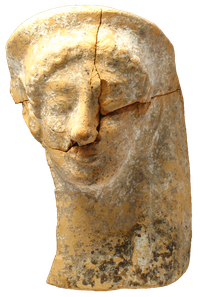Female protome TI-8
Description: The protome consists of a female head with a long neck. A veil falls from the broad low diadem in flat longitudinal folds (only preserved on the left). The hair lies in two registers of parallel wavy strands over the forehead, forms a flat pediment, then embraces the temples and ends in front of the ears. Tight carriage tapers towards the slightly protruding chin. The full lower lip curves downwards. Shape and course of the upper lip cannot be judged with certainty because of the damage. Slightly domed eyeballs, framed by narrow lids, lie under high orbitals. Without retraction in the region of the root of the nose, the long narrow nose merges directly into the forehead. The right ear sits higher than the left; helix and anthelix are indicated. Flat discs adorn the earlobes.
Commentary: Female head protomes like the present one were offered as votive gifts to the gods[2] or given to the deceased in their tombs[3]. They were widespread throughout Hellas, but had a focus in the eastern Mediterranean region[4]. The Giessen protome differs from most of the specimens in the group by having adjacent ears and a relatively narrow, slightly longer lower face. The diadem, which forms a flat arch slightly drawn out in width, is reminiscent of corresponding forms on standing and enthroned female figures from Rhodes[5] and from the northwestern Black Sea coast[6]. With the conspicuously high orbitals, the low elongated eyeballs and the contour line delimiting the relatively taut lower face and the strong chin, T I-8 stands next to protomes from Ionia from the beginning of the 5th century BC[7]. Whether the specimen was made in a native workshop and exported to the Bosporan Empire or was already made there, or whether it reached the Vogell Collection from the northern coast of the Black Sea or was acquired in another region, must remain open for the time being.
Determination: 480 BC; presumably Ionic.
[1] In cat. J. Boehlau, Griechische Altertümer südrussischen Fundorts (Kassel 1908), it is probably mentioned on p. 64 under no. 682 in connection with the inv. no. Giessen T I-46, which can be proven to come from the Vogell Collection. Boehlau's height specification agrees with that of T I-8.
[2] Chr. Blinkenberg, Lindos 1, Les petits objets (Berlin 1931) 10-14.
[3] B. Vierneisel-Schlörb, Die figürlichen Terrakotten. Kerameikos XV (München 1997) 37-39.
[4] Rhodes: R. A. Higgins, Cat. of the Terracottas (London 1954) 67 nos. 134-148 pls. 25-28; S. Mollard-Besques, Cat. raisonné des figurines et reliefs en terre-cuite grecs, étrusques et romains I (Paris 1954) 37 f. B 215-220 pl. 27; Blinkenberg ibid. 594-602 nos. 2447-2516 pls. 114-119. Delos: A. Laumonier, Délos 23 (Paris 1956) 103 f. no. 252 pl. 26; nos. 116. 118 pl. 14. Kreta: F. Croissant, Les protomés féminines archaïques (Paris 1983) 86-92 nos. 48-52 pls. 25-27.
[5] Higgins ibis. 62 f. 65 nos. 112. 113. 127 pls. 21 and 23; .
[6] Pharmakowsky, AA 29, 1914, 227 f. fig. 41.
[7] Higgins ibid. 70 no. 147 pl. 27; Croissant ibid. 86-88 no. 48 pl. 25; S. 91-93 no. 52 pl. 26. Blinkenberg ibid. 518 f. no. 2143 pl. 97; Laumonier ibid. 76 no. 120 pl. 14.

